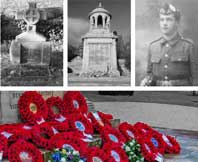
- Details
- Category: website
The team do not have any immediate plans to undertake the same research for our WW2 fallen. We would also need to raise money to pay for the internet searches, web hosting and publication costs. However, we do already have quite a bit of information and would welcome completed copies of the recording form and photographs from relatives of the fallen. We will keep this information on file for when the day comes that we, or someone else, is ready to take the project forward.
Please download and complete the recording form and return to us by email or by post to Hillcroft, Station Road, Rhu, by Helensburgh, G84 8LW. Don’t worry if you do not have all of the information, some is a good starting point. If you have very little information we would recommend starting your own research at the Commonwealth War Graves Commission website.
Thank you.
Download pdf WMFP recording form WW2
Download MS word doc WMFP recording form WW2
- Details
- Category: website
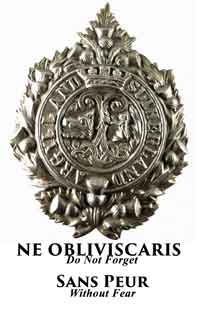
Of the 206 names carved on Helensburgh War Memorial, 63 of them served with the Argyll and Sutherland Highlanders. A further four Helensburgh men who died, but who are not named on the memorial, also served with the Argylls.
Helensburgh’s local regiment was originally the 1st Dumbartonshire Rifle Volunteers Corps, which became the 9th Battalion ‘A’ Company of Princess Louise’s Argyll and Sutherland Highlanders in 1908.The regiment was formed when the 91st and 93rd Regiment of Foot were merged in 1881.The 91st and 93rd were founded respectively in 1794 by John Campbell, 5th Duke of Argyll and 1799 by Major-General William Wemyss for the Countess of Sutherland. In 1854 the 93rd Regiment of Foot were the ‘Thin Red Line’ immortalised by William Russell for their actions at the Battle of Balaklava in the Crimean War. In 1871 the 91st Regiment provided a Guard of Honour at the wedding of Princess Louise, fourth daughter of Queen Victoria, to John Campbell, Marquis of Lorne and later Duke of Argyll. The 91st Regiment was subsequently renamed Princess Louise’s Argyllshire Highlanders. Princess Louise, Duchess of Argyll developed a great fondness for the Regiment and served as its Colonel in Chief until her death in 1914.
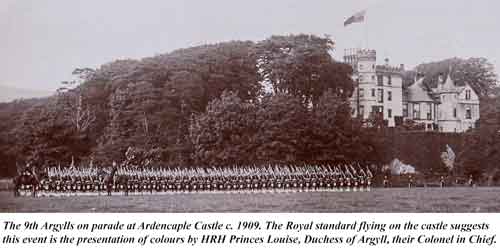
The 9th Battalion was formed in 1908, following the Territorial and Reserve Forces Act of 1907. Volunteer forces throughout the UK, including the 1st Dumbartonshire Rifle Volunteer Corps, were disbanded and absorbed into new Territorial Force battalions. The Commanding Officer in 1909 was Colonel Sir Alexander Wellesley Leith Buchanan of Ross Priory. In 1911 the headquarters of the County Territorials moved from Helensburgh to the mansion house of Hartfield in Dumbarton. The 9th Argylls (Dumbartonshire) Battalion, 1000 soldiers, comprised eight companies.
- A Company Helensburgh and Cardross
- B Company Kirkintilloch, Cumbernauld and Lenzie
- C Company Dumbarton
- D Company Milngavie
- E Company Jamestown and Bonhill
- F Company Alexandria and Renton
- G Company Clydebank
- H Company Clydebank
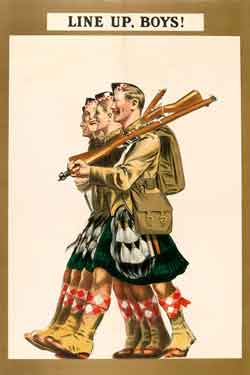
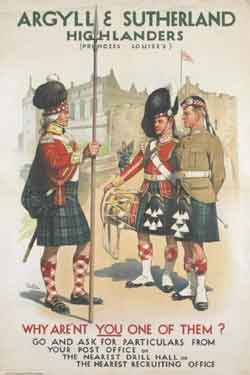 At the outbreak of World War I the regiment had nine battalions, each of 1000 men - two regular, the 1st and 2nd; two militia, the 3rd and 4th and five territorial battalions the 5th - 9th (each of which was split into 1st, 2nd and 3rd-line Battalions). Seven more Service Battalions were raised for 'Kitchener's Army' and they were numbered 10th, 11th, 12th, 13th, 14th, 15th and 16th.
At the outbreak of World War I the regiment had nine battalions, each of 1000 men - two regular, the 1st and 2nd; two militia, the 3rd and 4th and five territorial battalions the 5th - 9th (each of which was split into 1st, 2nd and 3rd-line Battalions). Seven more Service Battalions were raised for 'Kitchener's Army' and they were numbered 10th, 11th, 12th, 13th, 14th, 15th and 16th.
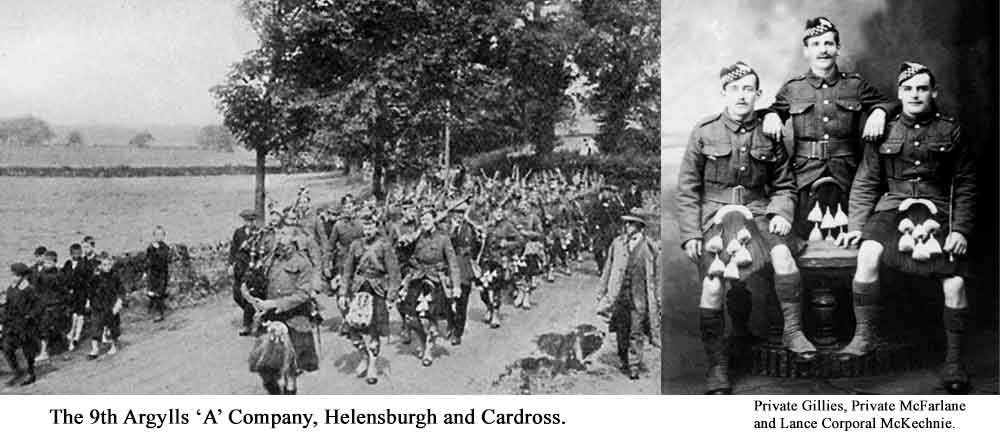
Ten battalions served in France and Flanders (the 1st, 2nd, 5th, 6th, 7th, 8th, 9th, 10th, 11th and 14th) and four (1st, 5th, 6th and 12th) served in southern Europe and the Mediterranean area at Gallipoli and Salonika. Over the course of the war the regiment lost 6,900 men and was awarded six Victoria Crosses. 65 Battle Honours were awarded to the Regiment for service in France and Flanders with Major Battle Honours awarded for service at Mons 1914; Le Cateau 1914; Marne 1914-1918; Ypres 1915; Passchendaele 1916; Arras 1917 and Cambrai 1917. In the Mediterranean theatre of war thirteen battle honours were awarded with Major Battle Honours awarded for service at Gaza 1916 and Doiran 1917. The 9th Argylls were awarded Battle Honours for Ypres 1915 and St Julien, France and Flanders 1914-18.
When war was declared on 4 August 1914 the local Territorials were at camp in Kintyre and quickly returned to headquarters in Dumbarton. The Battalion’s Commanding Officer, Colonel Leith-Buchanan, was not passed fit for service overseas and was replaced by Lieutenant Colonel James Clark. On the morning of 11 August 1914, the 1st / 9th Battalion mustered on the Common before leaving for Bedford by train, where they underwent training before being deployed to France. They sailed to Le Havre six months later, on the night of 19/20 February 1915 and, attached to the 81st Brigade in the 27th Division, they were soon engaged in battle in the Ypres Salient.
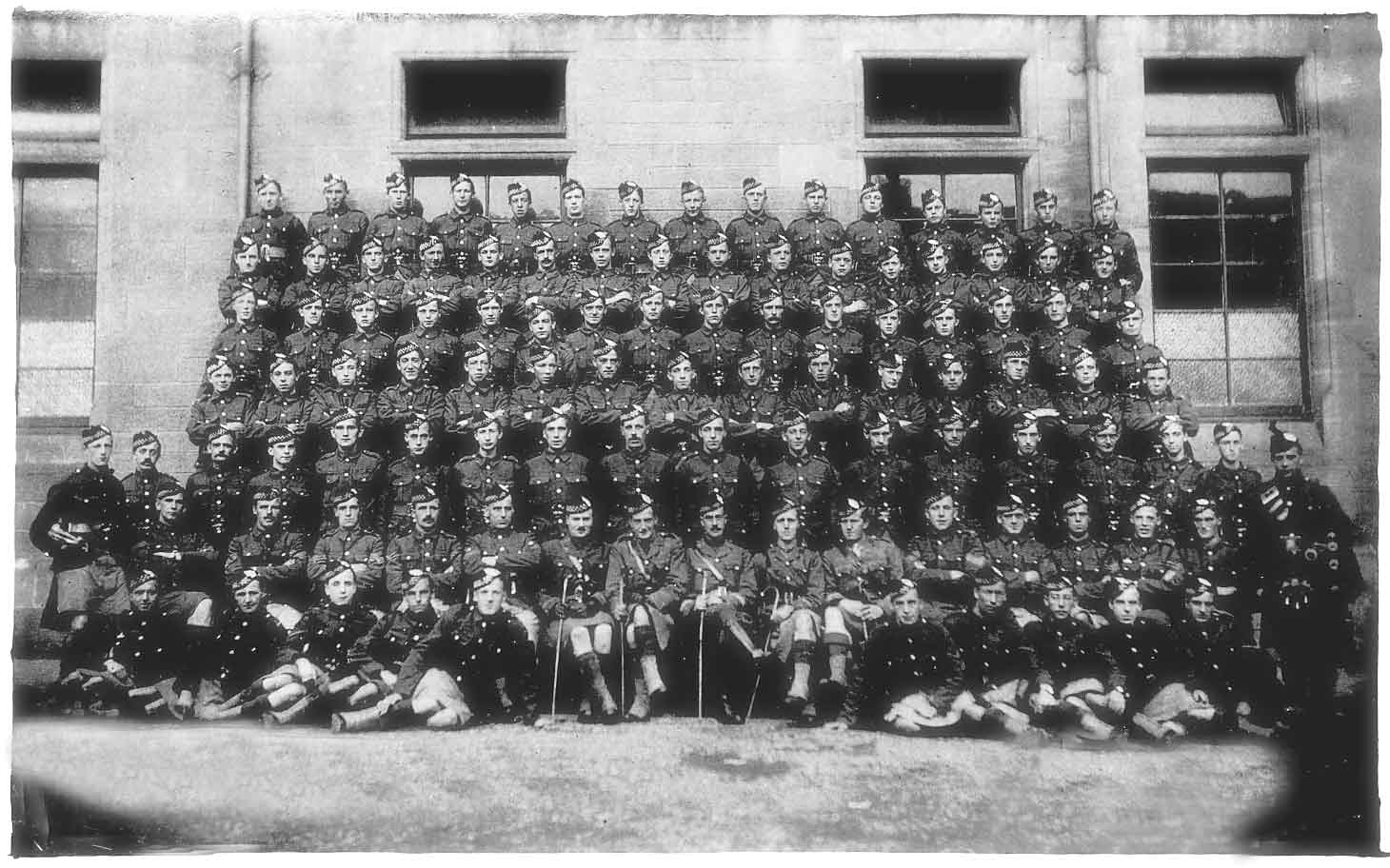
Argyll and Sutherland Highlanders
Casualties were light during the first two months in Flanders with the first men wounded on 10 March 1915. On 20 March Helensburgh man Corporal George McKay was the first 9th Argyll to be killed in action. However, the battalion was soon to meet a terrible fight in the Second Battle of Ypres where 59,000 British soldiers died between 22 April and 25 May.
‘A letter from the Front’ believed to have been written by Helensburgh man Corporal Neil Sharkey describes the fighting first-hand between 10 and 17 May 1915. On 10 May 1915 the 9th Argylls lost 12 officers and 300 men including their commanding officer Colonel Clark. Helensburgh men George Allan, Herbert Brown, David Dorward and George McGeachy perished in the battle. The Germans used poisonous chlorine gas for the first time in this battle and a gas attack on 24 May overwhelmed the 9th Argylls, who were fighting at the front with the Royal Dublin Fusiliers. When the Argylls were formally withdrawn from the front line at the end of 24 May there were only two officers and 85 men left of the 9th Argylls, they had lost over 900 men in two weeks.
As news of the battle reached Dumbartonshire a telegram, copied in the Helensburgh and Gareloch Times, was sent by Major Cockburn, Secretary of the Dumbarton Territorials Force Association, to the War Office:-
"Anxiety here arisen out of reports of heavy losses to the 9th Argylls. Can you communicate any information to allay this"?
War Office reply:- "Names of all officers reported already communicated to next-of-kin. Names of rank and file not yet received but numbers killed not very heavy".
The Second Battle of Ypres decimated the 9th Argylls, the survivors of the Dumbartonshire Battalion were amalgamated with the 1st / 7th Battalion, who had also suffered heavy losses at Ypres. It was impossible to bring the Dumbartonshire Battalion back up to full strength through local recruitment as so many men in the county were engaged in essential industry and eventually by August 1915 the 9th Argylls were formally disbanded. Helensburgh and Dumbartonshire Argyll and Sutherland Highlanders continued to serve in other battalions of the regiment and, as was often the case in the war, were transferred to other regiments and services as needed.
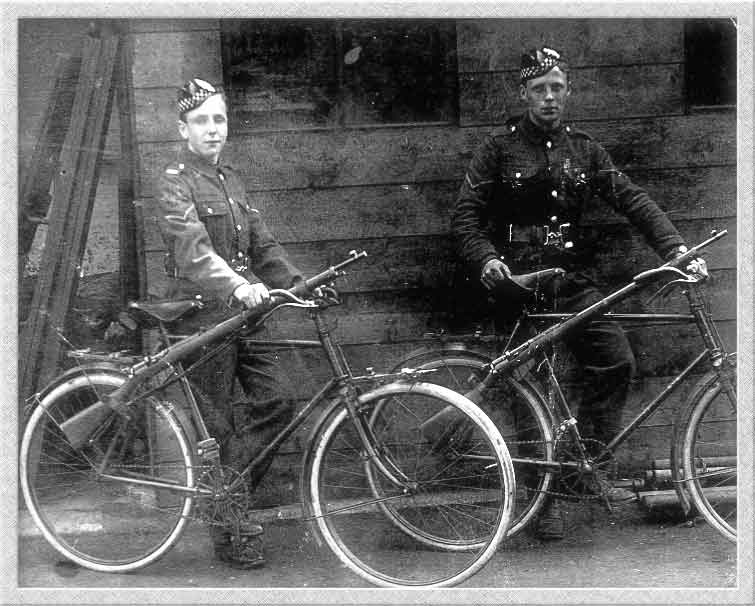
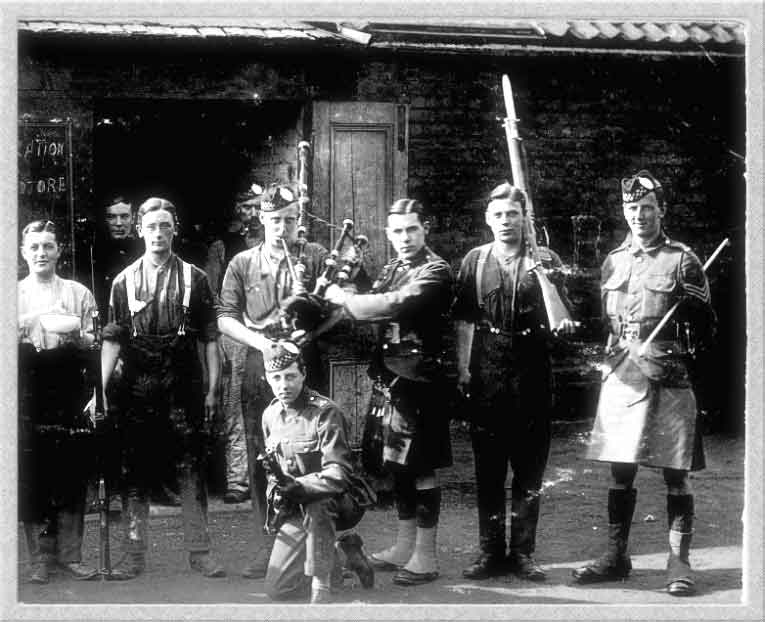 Dear Lord Inverclyde,
Dear Lord Inverclyde,
I would much like the relations and friends and all survivors of the 9th Battalion of the Argyll and Sutherland Highlanders to know how deeply I sympathise with them in their loss, and would you kindly convey this to them from me. The gallantry and fortitude of our splendid men, who have so nobly given their lives in the recent engagement in France for their country and King, so glowingly referred to by Sir John French must, I feel sure, be a source of pride and will help them in their bereavement.
Believe me. Your Sincerely, Louise.
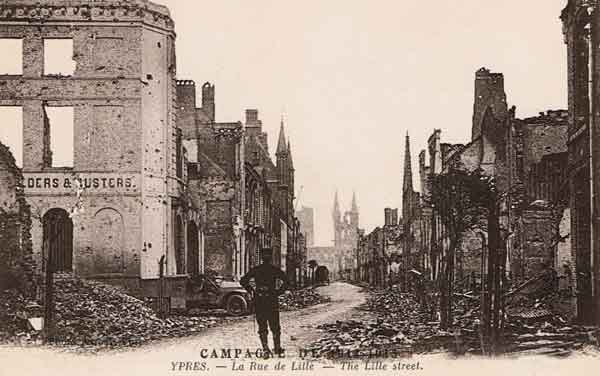
Ypres 1914 - 1915
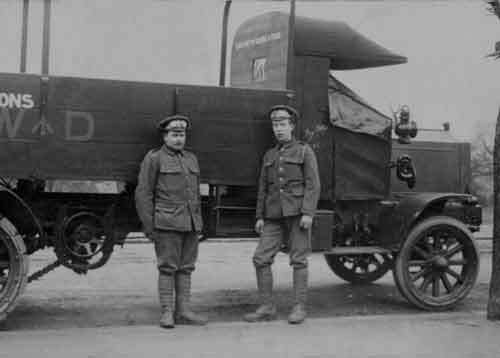
Helensburgh Argylls, P Stewart and H Brown.
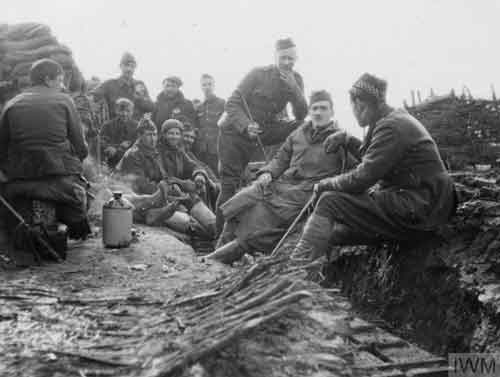
Argyll and Sutherland Highlanders 1914-15 at the Western Front. ©Imperial War Museum
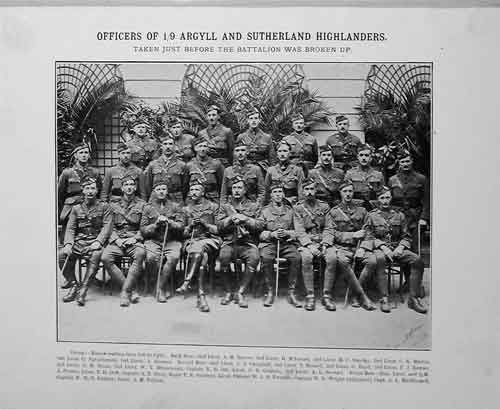

Helensburgh man Lance Sergeant George McKinlay MacKay, ‘A’ Company, 1st / 9th Battalion Argyll and Sutherland Highlanders was the first Argyll and Sutherland Highlander to die in the war. He was killed by sniper fire at Ypres on 20 March 1915,
A tribute to him was written by Private Lachlan McDiarmid from Alexandria –
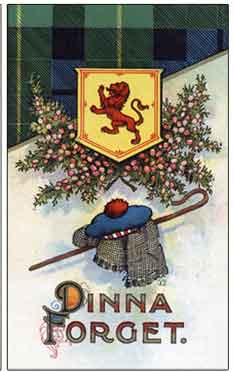 “It’s hard to lose a comrade, one you know, so kind and true,
“It’s hard to lose a comrade, one you know, so kind and true,
Willing to help — a better pal, in fact, there are few —
He was doing his duty, along with the rest,
Marching to the trenches, German hordes to test,
Hit by a bullet, our gallant Sergeant fell.
“His comrades gathered around him as he lay upon the ground,
They did the best they could, but he uttered not a sound,
Along the road they carried him, their hearts were sore that night,
For they had lost a comrade, who with them no more would fight,
In a little spot in Belgium, he lies buried with the brave.
“Always will he be remembered among the rank and file,
He did his duty nobly with the gallant 9th Argyll;
And when we come marching back again, Bonnie Scotland dear to see,
We'll remember our young Sergeant, wherever he may be;
Then we'll tell you of his kindness, and his cheery smile,
And of how a brave young Sergeant fell with the 9th Argyll.”
- Details
- Category: website
Sources Consulted
- A Street Near You www.astreetnearyou.org
- Ancestry www.ancestry.co.uk
- Armed Forces Veterans https://armedforcesveterans.org.uk/
- Australia War Memorial www.awm.gov.au
- Australian National War Memorial www.awm.gov.au
- Clyde Ships www.clydeships.co.uk
- Commonwealth War Graves Commission www.cwgc.org
- Corpus Christi Oxford Roll of Honour www.ccc.ox.ac.uk/about-corpus/rolls-honour/roll-honour-1914-1918
- De Ruvigny Roll of Honour www.greatwar.co.uk
- Everyone Remembered www.everyoneremembered.org
- Fettes College www.fettes.com
- Find a Grave www.findagrave.com
- Forces War Records www.forces-war-records.co.uk
- Great War www.greatwar.co.uk
- Great War Dundee Project www.greatwarproject.org
- Helensburgh Heritage Trust www.helensburgh-heritage.co.uk
- Helensburgh Library www.liveargyll.co.uk/facility/helensburgh-library
- Helensburgh and Gareloch Times 1914-20 Helensburgh Library
- Imperial War Museum www.iwm.org.uk
- Inverclyde Great War Project www.inverclydeww1.org
- Larchfield School Roll of Honour Lomond School
- Lives at the First World War website www.livesofthefirstworldwar.iwm.org.uk
- The Long, Long Trail www.longlongtrail.co.uk
- Merchiston Castle School Roll of Honour www.archive.org/details/rollofhonour19141921merc
- National Archives of Australia www.Naa.gov.au
- National Archive – MAB Services www.nationalarchives.gov.uk
- National War Museum (Scotland) www.nms.ac.uk/war
- Naval-History.net www.naval-history.net
- New Zealand National War Memorial www.mch.govt.nz/pukeahu/park/national-war-memorial
- Passchendaele Archives www.passchendaele.be
- Rhodesian Services Association www.rhodesianservices.org
- Rootsweb www.rootsweb.com
- Royal Bank of Canada Roll of Honour www.rbc.com/history/celebrating-our-history/in-remembrance/wwi-roll-of-honour-list.html
- SMRG-CP www.scottishmilitaryresearch.co.uk
- Scotland’s People www.scotlandspeople.gov.uk
- Scotland’s War www.scotlandswar.co.uk
- Scottish National War Memorial www.nms.ac.uk
- Scottish War Graves www.scottishwargraves.phpbbweb.com
- The Scottish Military Research Project www.scottishmilitaryresearch.co.uk
- The University of Aberdeen Roll of Honour www.abdn.ac.uk/special-collections/roll-of-honour/index.php
- The University of Glasgow Roll of Honour www.universitystory.gla.ac.uk/ww1-intro/
- Vale of Leven history www.valeofleven.org.uk
- Veterans Affairs Canada www.veterans.gc.ca
- Wartime Memories www.wartimememories.co.uk
- War Memorials Online www.warmemorials.org.uk
- Wikipedia www.wikipedia.org
Contributors / Informants
Soldiers
- James Black – Sheila Hart (grand-daughter)
- Connell Bruce – Lisa Marshall
- Charles Dodds – Graham Dods
- Charles and James Law – P Worms
- Bernard McDonald – Martin Taylor
- John Thomson McDougall – Robert Hepburn
- James McGhee – Irene McIntyre
- Neil Sharkey – John McKenzie
- John Rice – Ronnie Gallagher and Derek Stocks
- James Speirs – James Spiers
- Daniel Ward – Mrs Rosemary Livingston
- Thanks are due to the following for their assistance to the project:
- Kate and Richard Annis
- Daniel Harkin
- Freya Holliman
- Penny Johnston
- Sandy Kerr
- Thomas MacLean
- Douglas Sammon
- George Vidits
Acknowledgements
- Argyll and Sutherland Highlanders archive and museum (Allison Spark)
- Helensburgh Churches
- Cemeteries/ War Memorials images - Courtesy of Commonwealth War Graves Commission
- Christchurch City Council, New Zealand (Canterbury Provincial War Memorial)
Portraits
- Lieutenant A. Leslie Hamilton. Painted by Sir James Guthrie. CSG CIC Glasgow Museums Collection
- William Bryson, Provost 1884-90. Painted by James Duncan Argyll and Bute Council.
- David S MacLachlan, Provost 1908 -1911. Painted by unknown artist © Argyll and Bute Council
- Details
- Category: website
Sources Consulted
- A Street Near You www.astreetnearyou.org
- Ancestry www.ancestry.co.uk
- Armed Forces Veterans https://armedforcesveterans.org.uk/
- Australia War Memorial www.awm.gov.au
- Australian National War Memorial www.awm.gov.au
- Clyde Ships www.clydeships.co.uk
- Commonwealth War Graves Commission www.cwgc.org
- Corpus Christi Oxford Roll of Honour www.ccc.ox.ac.uk/about-corpus/rolls-honour/roll-honour-1914-1918
- De Ruvigny Roll of Honour www.greatwar.co.uk
- Everyone Remembered www.everyoneremembered.org
- Fettes College www.fettes.com
- Find a Grave www.findagrave.com
- Forces War Records www.forces-war-records.co.uk
- Great War www.greatwar.co.uk
- Great War Dundee Project www.greatwarproject.org
- Helensburgh Heritage Trust www.helensburgh-heritage.co.uk
- Helensburgh Library www.liveargyll.co.uk/facility/helensburgh-library
- Helensburgh and Gareloch Times 1914-20 Helensburgh Library
- Imperial War Museum www.iwm.org.uk
- Inverclyde Great War Project www.inverclydeww1.org
- Larchfield School Roll of Honour Lomond School
- Lives at the First World War website www.livesofthefirstworldwar.iwm.org.uk
- The Long, Long Trail www.longlongtrail.co.uk
- Merchiston Castle School Roll of Honour www.archive.org/details/rollofhonour19141921merc
- National Archives of Australia www.Naa.gov.au
- National Archive – MAB Services www.nationalarchives.gov.uk
- National War Museum (Scotland) www.nms.ac.uk/war
- Naval-History.net www.naval-history.net
- New Zealand National War Memorial www.mch.govt.nz/pukeahu/park/national-war-memorial
- Passchendaele Archives www.passchendaele.be
- Rhodesian Services Association www.rhodesianservices.org
- Rootsweb www.rootsweb.com
- Royal Bank of Canada Roll of Honour www.rbc.com/history/celebrating-our-history/in-remembrance/wwi-roll-of-honour-list.html
- SMRG-CP www.scottishmilitaryresearch.co.uk
- Scotland’s People www.scotlandspeople.gov.uk
- Scotland’s War www.scotlandswar.co.uk
- Scottish National War Memorial www.nms.ac.uk
- Scottish War Graves www.scottishwargraves.phpbbweb.com
- The Scottish Military Research Project www.scottishmilitaryresearch.co.uk
- The University of Aberdeen Roll of Honour www.abdn.ac.uk/special-collections/roll-of-honour/index.php
- The University of Glasgow Roll of Honour www.universitystory.gla.ac.uk/ww1-intro/
- Vale of Leven history www.valeofleven.org.uk
- Veterans Affairs Canada www.veterans.gc.ca
- Wartime Memories www.wartimememories.co.uk
- War Memorials Online www.warmemorials.org.uk
- Wikipedia www.wikipedia.org
Contributors / Informants
Soldiers
- James Black – Sheila Hart (grand-daughter)
- Connell Bruce – Lisa Marshall
- Charles Dodds – Graham Dods
- Charles and James Law – P Worms
- Bernard McDonald – Martin Taylor
- John Thomson McDougall – Robert Hepburn
- James McGhee – Irene McIntyre
- Neil Sharkey – John McKenzie
- John Rice – Ronnie Gallagher and Derek Stocks
- James Speirs – James Spiers
- Daniel Ward – Mrs Rosemary Livingston
- Thanks are due to the following for their assistance to the project:
- Kate and Richard Annis
- Daniel Harkin
- Freya Holliman
- Penny Johnston
- Sandy Kerr
- Thomas MacLean
- Douglas Sammon
- George Vidits
Acknowledgements
- Argyll and Sutherland Highlanders archive and museum (Allison Spark)
- Helensburgh Churches
- Cemeteries/ War Memorials images - Courtesy of Commonwealth War Graves Commission
- Christchurch City Council, New Zealand (Canterbury Provincial War Memorial)
Portraits
- Lieutenant A. Leslie Hamilton. Painted by Sir James Guthrie. CSG CIC Glasgow Museums Collection
- William Bryson, Provost 1884-90. Painted by James Duncan Argyll and Bute Council.
- David S MacLachlan, Provost 1908 -1911. Painted by unknown artist © Argyll and Bute Council
- Details
- Category: website
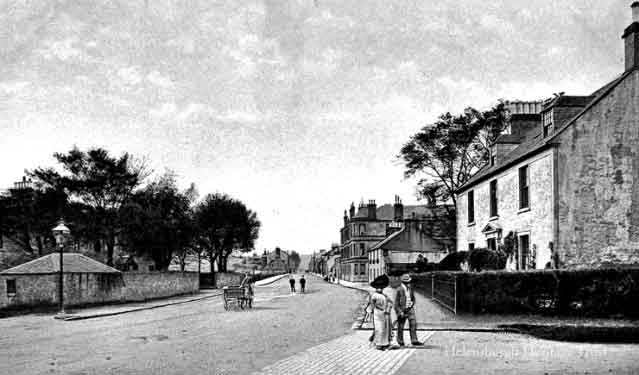 The summer of 1914 and the town of Helensburgh was bustling with holiday-makers. This new town, was built on a grid system with large building plots and tree-lined streets. It soon became a favourite retreat for the wealthy of Glasgow to spend the summer months away from the industrial smog and the stench of the River Clyde. Many rich merchants had built large villas in the town which boasted tennis courts, swimming pool, golf course and sailing clubs; all the luxury leisure activities that most small towns, at that time, could only dream off.
The summer of 1914 and the town of Helensburgh was bustling with holiday-makers. This new town, was built on a grid system with large building plots and tree-lined streets. It soon became a favourite retreat for the wealthy of Glasgow to spend the summer months away from the industrial smog and the stench of the River Clyde. Many rich merchants had built large villas in the town which boasted tennis courts, swimming pool, golf course and sailing clubs; all the luxury leisure activities that most small towns, at that time, could only dream off.
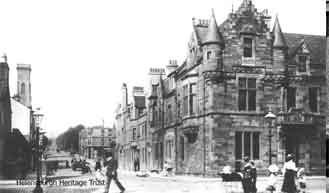 The local paper, The Helensburgh & Gareloch Times, listed the names of these families and the dates they were travelling by steamer from the city, so that friends could arrange to meet them and to send invitations to the social occasions; many of the larger homes hosting summer balls and musical evenings.
The local paper, The Helensburgh & Gareloch Times, listed the names of these families and the dates they were travelling by steamer from the city, so that friends could arrange to meet them and to send invitations to the social occasions; many of the larger homes hosting summer balls and musical evenings.
Although the war in Europe filled the pages of the national papers with much speculation, life for most went on as before. The local paper made its first reference in its 1914, August 12th issue:- " War was declared between Great Britain and Germany late on Tuesday evening of last week, and now a great European War is being waged, the result of which no man can foresee." wrote its editor.
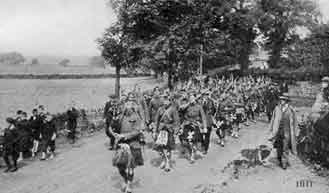 Over the next few weeks, many of the town's young men would join various Scottish regiments and the Royal Navy as recruiting started in earnest. With a population of around only eight and a half thousand, there were few who did not have someone, family or friend, away with Lord Kitchener's New Army. With a fervour, previously unknown, men were encouraged to join up to fight for King, country and glory.
Over the next few weeks, many of the town's young men would join various Scottish regiments and the Royal Navy as recruiting started in earnest. With a population of around only eight and a half thousand, there were few who did not have someone, family or friend, away with Lord Kitchener's New Army. With a fervour, previously unknown, men were encouraged to join up to fight for King, country and glory.
But a look through the local newspaper, of the time, also gives an insight into the changes being made at home. Although it was said, " it will all be over by Christmas ", shops were advertising ideal Christmas gifts for those overseas. Handy items like a thermos flask, torch or religious books in khaki.
Adverts also started to appear giving the service of dyeing your clothes black should you require mourning dress. Lawnmowers for the gardens whose owners could no longer employ a squad of young men with scythes. Gas fires now that the girls were leaving service to go into nursing or the munitions factories and no longer there to clean and set a coal fire. Old men and young boys struggled to maintain the large gardens of this "Garden City on the Clyde" as it was called in the holiday pamphlets. Local women worked daily to replace the live-in staff.
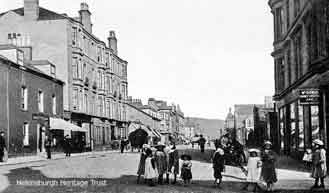 Younger ladies of the house spent their leisure time knitting socks for their brothers and sweethearts at the front. The social order was shifting. The letters home that were published in the local newspaper, were much anticipated as people craved the latest news from the front. The local Picture House, the La Scala, advertised that, "news of importance would be screened each evening as received". No doubt increasing the audience numbers.
Younger ladies of the house spent their leisure time knitting socks for their brothers and sweethearts at the front. The social order was shifting. The letters home that were published in the local newspaper, were much anticipated as people craved the latest news from the front. The local Picture House, the La Scala, advertised that, "news of importance would be screened each evening as received". No doubt increasing the audience numbers.
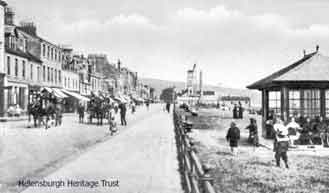 But the town changed throughout and after the war. Without staff in service, the big houses were divided to provide smaller, more easily maintained accommodation. Some used as nursing homes or hotels. Without a son and heir many small family businesses and shops disappeared or were taken over by an early form of High Street traders. A generation of young men were lost. The town returned to being a holiday destination, but was never the same again.
But the town changed throughout and after the war. Without staff in service, the big houses were divided to provide smaller, more easily maintained accommodation. Some used as nursing homes or hotels. Without a son and heir many small family businesses and shops disappeared or were taken over by an early form of High Street traders. A generation of young men were lost. The town returned to being a holiday destination, but was never the same again.
